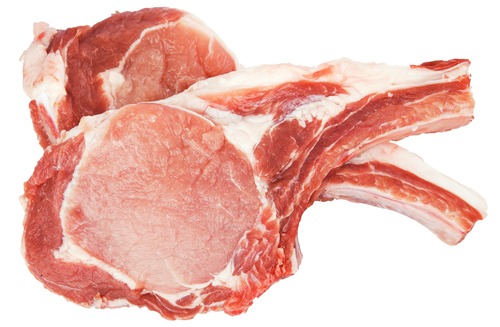In the seeming avalanche that is bad food news, it can be hard to know just how riled up to get about bacteria in meat. Yes, raw meat is a silent time-bomb, but then you cook the heck out of it, scrub your counters with bleach, and the problem is solved — right?
On the surface this may seem to be the case, but what happens when those bacteria have mutated to resist antibiotics? Several studies, including one last January out of the University of Iowa, have found that such bacteria are widely present in grocery store pork. And now Consumer Reports has found similarly alarming results in nearly 200 samples of both pork chops and ground pork. In fact, like others, today’s study shows that more pork contains antibiotic-resistant bacteria than doesn’t.
In addition to salmonella, staphylococcus aureus (the bacteria most known to cause staph infections), and listeria, the Consumer Reports study also found that an alarming percentage of the samples — or 69 percent — contained a bacteria called Yersinia enterocolitica, which is known to cause violent intestinal illness in young children. According to Helena Bottemiller at Food Safety News, “There is approximately one confirmed [Yersinia] infection per 100,000 people reported each year, but since these cases are severely under-reported, CDC estimates there are actually around 100,000 infections in the United States annually.” And most often it is tied to pork.
According to Urvashi Rangan, Consumer Reports’ director of consumer safety, Yersinia is “something the USDA had plans to test for in their most recent study of hogs, but didn’t follow through on.” It’s hard to understand why, she adds, considering more than two-thirds of the pork the group looked at tested positive for the scary, if less well-known, bacteria. What’s more frightening is the fact that over 90 percent of the Yersinia tested was resistant to one or more antibiotics — a fact that makes treatment more expensive and time-consuming when one is exposed.
“We are asking USDA to look more closely at Yersinia and require it for pork producers to have to manage as part of their hygiene programs,” Rangan says.
Consumer Reports also looked at ractopamine, the controversial drug otherwise known as Paylean, that many American hog farmers feed to animals to make them leaner and more muscular right before slaughter. The study found very low but detectable levels of ractopamine in one-fifth of the samples tested. And while there has been little science to suggest that human exposure to the drug is dangerous — there has also been very little to suggest the opposite. The only known study, to be precise, was conducted on six healthy men.
Beta-agonist drugs like ractopamine are known to cause restlessness, anxiety, fast heart rates, and other effects, however, so Rangan describes the science as “really inadequate,” adding, “We know nothing about the effects on children or vulnerable populations.” In the case of animals, the Food and Drug Administration reported that at least 160,000 pigs have been sickened or killed by the drug.
Add to all that the fact that ractopamine doesn’t appear on labels because it is technically neither an antibiotic nor a hormone, so even certified antibiotic-free animals may have been treated with the drug. For these reasons, Consumers Union, the advocacy arm of Consumer Reports, is calling for a ban on ractopamine.
Rangan says today’s study results underscore a larger conversation Consumer Reports and Consumers Union have been having for over a decade about the overuse of antibiotics in meat production. “Our position is that these drugs should not be used for purposes other than treating sick animals,” she says.
A survey the group took back in June reinforced this position when it found that a majority of respondents “were extremely or very concerned about issues related to the use of antibiotics in animal feed, including the potential creation of ‘superbugs’ due to overuse of antibiotics, unsanitary and crowded conditions for livestock, human consumption of antibiotic residue, and environmental effects due to agricultural runoff containing antibiotics.”
Given the fact that a full 80 percent of the antibiotics we have in this country are being fed to factory farm animals, and the residue is ending up in our waterways, our farm fertilizer, and our bodies, it’s not hard to see why Consumer Reports and other groups are working hard to keep the issue on the radar of the government agencies that have the power to regulate these growth-promoting drugs.
Although the last year has seen several baby steps toward regulation — such as a court order and a move by the Obama administration to “puts steps in place” to create a ban — the livestock industry is ultimately still allowed to regulate itself. And, well, considering the fact that over 85 percent of the bacteria found in this latest test were resistant to at least one if not multiple common antibiotics (including amoxicillin, penicillin, tetracycline, and streptomycin), it’s easy to see just how well that’s working out.
Rep. Louise Slaughter (D-N.Y.) released a statement calling the results “terrifying.”
“It’s getting harder and harder for the food processing industry and the FDA to ignore the fact that the overuse of antibiotics in animals is threatening public health. Their half-measures and voluntary guidelines are no longer enough — we must act swiftly to reverse this public health crisis.” Last year, Slaughter introduced the Preservation of Antibiotics for Medical Treatment Act, which would “preserve the effectiveness of medically important antibiotics by phasing out the use of these drugs in healthy food-producing animals,” but — as you might guess — the bill has yet to make much headway in the current Congress.




